An Analysis of Sustainable and Reasonable Tourism in Australia
VerifiedAdded on 2023/03/20
|10
|2276
|72
Report
AI Summary
This report provides a comprehensive analysis of sustainable and reasonable tourism, focusing on the Australian tourism industry. It begins by defining sustainable tourism and relating it to UNWTO priorities, highlighting the importance of respecting the environment, culture, and local communities. The report then explores the similarities and differences between sustainable and reasonable tourism, emphasizing responsible tourist behavior. It examines global trends in sustainable tourism, such as the involvement of tourists in environmental preservation and the recognition of native cultures. The report also delves into the challenges faced by sustainable tourism, including a lack of defined rules and guidelines, and provides examples from Australia. The conclusion underscores the importance of sustainable tourism for socioeconomic growth and the role of Australia in promoting responsible tourism practices.
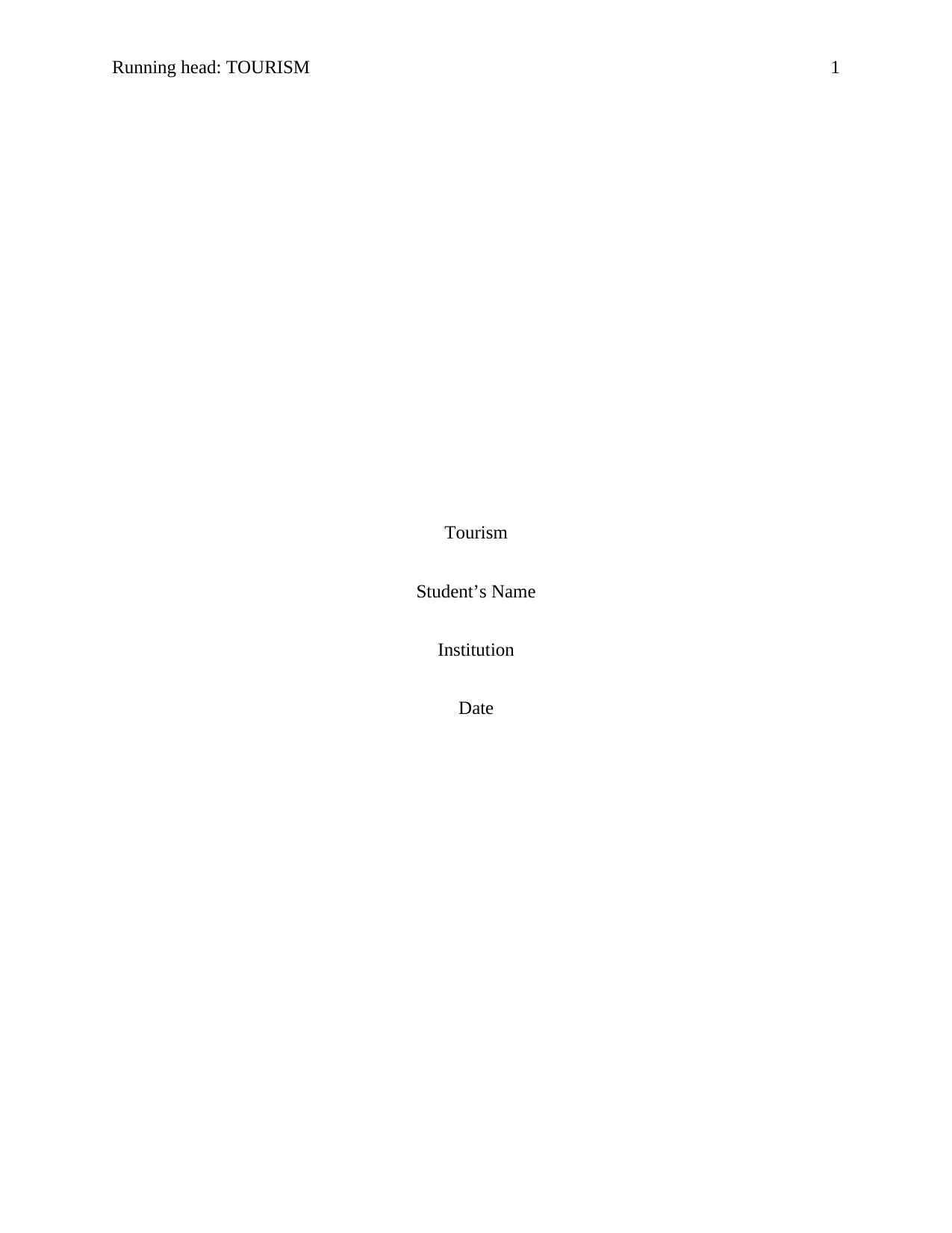
Running head: TOURISM 1
Tourism
Student’s Name
Institution
Date
Tourism
Student’s Name
Institution
Date
Paraphrase This Document
Need a fresh take? Get an instant paraphrase of this document with our AI Paraphraser
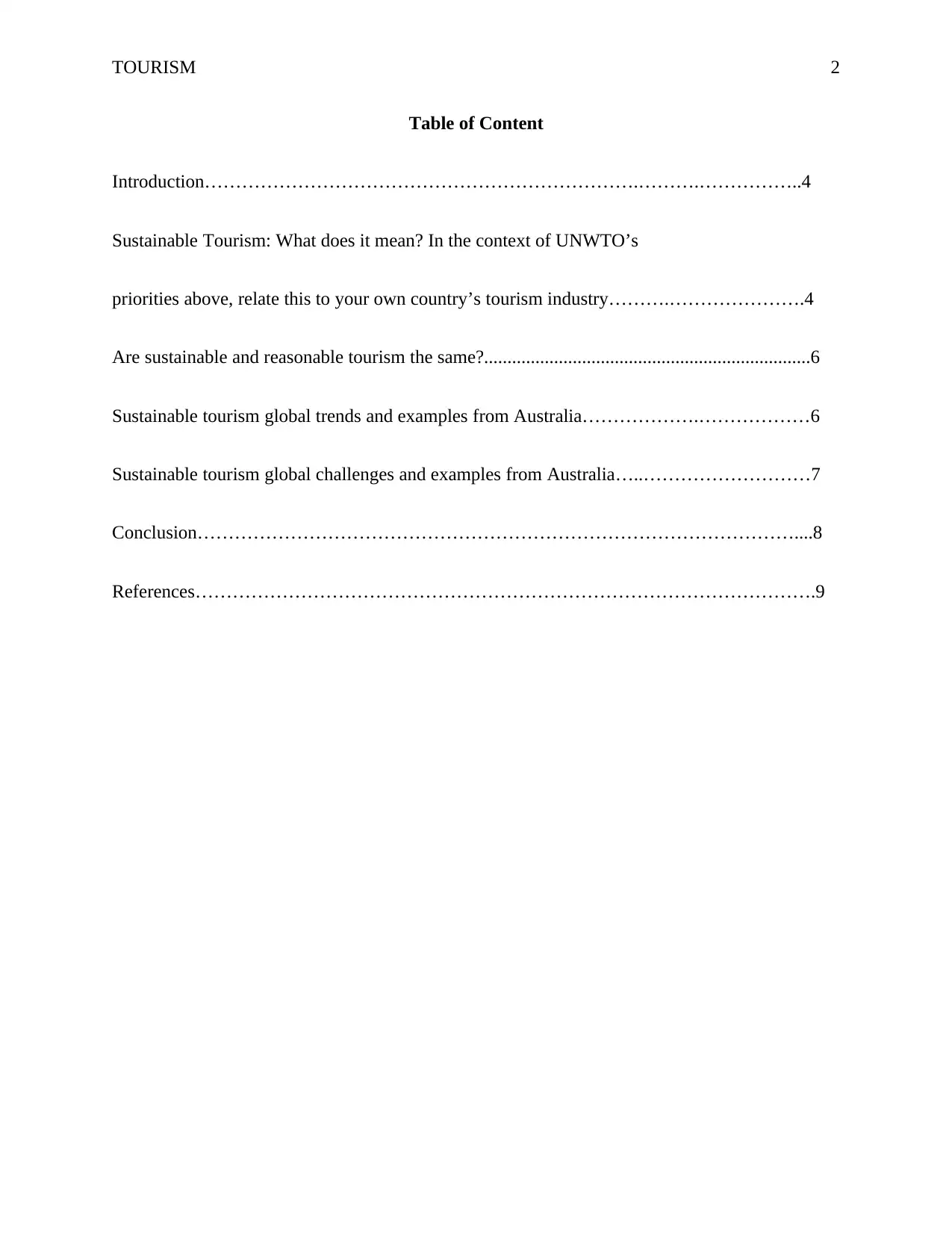
TOURISM 2
Table of Content
Introduction…………………………………………………………….……….……………..4
Sustainable Tourism: What does it mean? In the context of UNWTO’s
priorities above, relate this to your own country’s tourism industry……….………………….4
Are sustainable and reasonable tourism the same?......................................................................6
Sustainable tourism global trends and examples from Australia……………….………………6
Sustainable tourism global challenges and examples from Australia…..………………………7
Conclusion……………………………………………………………………………………....8
References……………………………………………………………………………………….9
Table of Content
Introduction…………………………………………………………….……….……………..4
Sustainable Tourism: What does it mean? In the context of UNWTO’s
priorities above, relate this to your own country’s tourism industry……….………………….4
Are sustainable and reasonable tourism the same?......................................................................6
Sustainable tourism global trends and examples from Australia……………….………………6
Sustainable tourism global challenges and examples from Australia…..………………………7
Conclusion……………………………………………………………………………………....8
References……………………………………………………………………………………….9
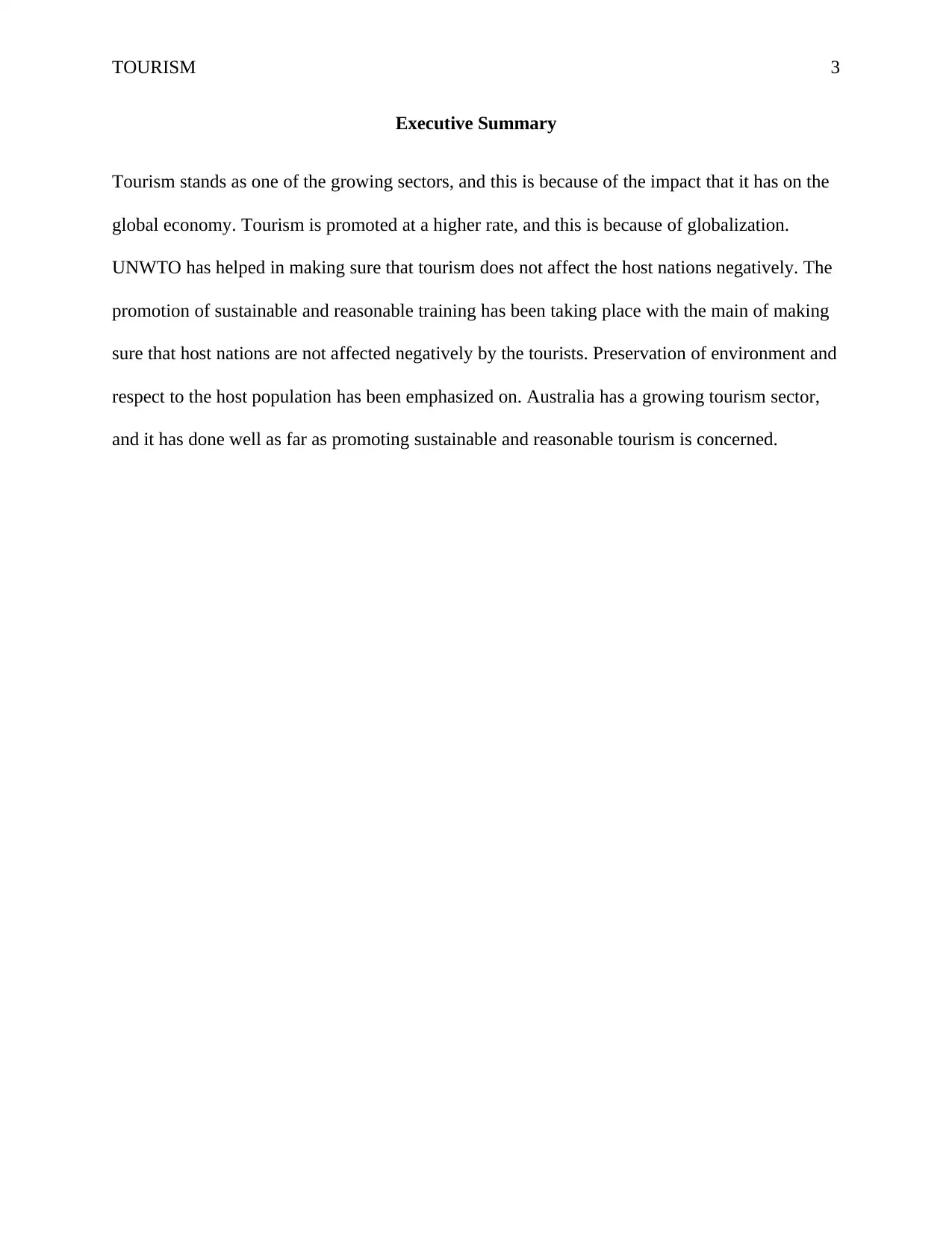
TOURISM 3
Executive Summary
Tourism stands as one of the growing sectors, and this is because of the impact that it has on the
global economy. Tourism is promoted at a higher rate, and this is because of globalization.
UNWTO has helped in making sure that tourism does not affect the host nations negatively. The
promotion of sustainable and reasonable training has been taking place with the main of making
sure that host nations are not affected negatively by the tourists. Preservation of environment and
respect to the host population has been emphasized on. Australia has a growing tourism sector,
and it has done well as far as promoting sustainable and reasonable tourism is concerned.
Executive Summary
Tourism stands as one of the growing sectors, and this is because of the impact that it has on the
global economy. Tourism is promoted at a higher rate, and this is because of globalization.
UNWTO has helped in making sure that tourism does not affect the host nations negatively. The
promotion of sustainable and reasonable training has been taking place with the main of making
sure that host nations are not affected negatively by the tourists. Preservation of environment and
respect to the host population has been emphasized on. Australia has a growing tourism sector,
and it has done well as far as promoting sustainable and reasonable tourism is concerned.
⊘ This is a preview!⊘
Do you want full access?
Subscribe today to unlock all pages.

Trusted by 1+ million students worldwide
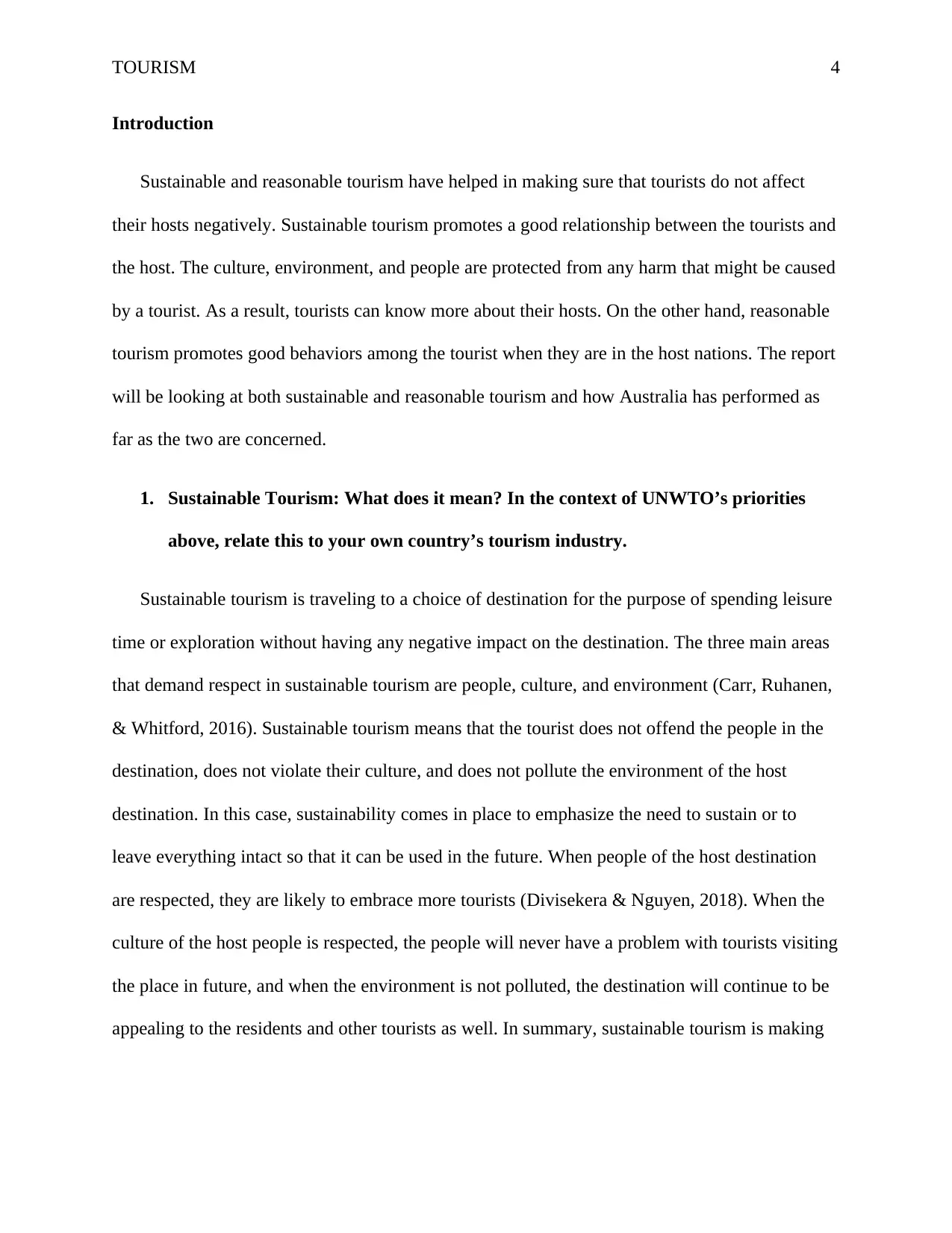
TOURISM 4
Introduction
Sustainable and reasonable tourism have helped in making sure that tourists do not affect
their hosts negatively. Sustainable tourism promotes a good relationship between the tourists and
the host. The culture, environment, and people are protected from any harm that might be caused
by a tourist. As a result, tourists can know more about their hosts. On the other hand, reasonable
tourism promotes good behaviors among the tourist when they are in the host nations. The report
will be looking at both sustainable and reasonable tourism and how Australia has performed as
far as the two are concerned.
1. Sustainable Tourism: What does it mean? In the context of UNWTO’s priorities
above, relate this to your own country’s tourism industry.
Sustainable tourism is traveling to a choice of destination for the purpose of spending leisure
time or exploration without having any negative impact on the destination. The three main areas
that demand respect in sustainable tourism are people, culture, and environment (Carr, Ruhanen,
& Whitford, 2016). Sustainable tourism means that the tourist does not offend the people in the
destination, does not violate their culture, and does not pollute the environment of the host
destination. In this case, sustainability comes in place to emphasize the need to sustain or to
leave everything intact so that it can be used in the future. When people of the host destination
are respected, they are likely to embrace more tourists (Divisekera & Nguyen, 2018). When the
culture of the host people is respected, the people will never have a problem with tourists visiting
the place in future, and when the environment is not polluted, the destination will continue to be
appealing to the residents and other tourists as well. In summary, sustainable tourism is making
Introduction
Sustainable and reasonable tourism have helped in making sure that tourists do not affect
their hosts negatively. Sustainable tourism promotes a good relationship between the tourists and
the host. The culture, environment, and people are protected from any harm that might be caused
by a tourist. As a result, tourists can know more about their hosts. On the other hand, reasonable
tourism promotes good behaviors among the tourist when they are in the host nations. The report
will be looking at both sustainable and reasonable tourism and how Australia has performed as
far as the two are concerned.
1. Sustainable Tourism: What does it mean? In the context of UNWTO’s priorities
above, relate this to your own country’s tourism industry.
Sustainable tourism is traveling to a choice of destination for the purpose of spending leisure
time or exploration without having any negative impact on the destination. The three main areas
that demand respect in sustainable tourism are people, culture, and environment (Carr, Ruhanen,
& Whitford, 2016). Sustainable tourism means that the tourist does not offend the people in the
destination, does not violate their culture, and does not pollute the environment of the host
destination. In this case, sustainability comes in place to emphasize the need to sustain or to
leave everything intact so that it can be used in the future. When people of the host destination
are respected, they are likely to embrace more tourists (Divisekera & Nguyen, 2018). When the
culture of the host people is respected, the people will never have a problem with tourists visiting
the place in future, and when the environment is not polluted, the destination will continue to be
appealing to the residents and other tourists as well. In summary, sustainable tourism is making
Paraphrase This Document
Need a fresh take? Get an instant paraphrase of this document with our AI Paraphraser
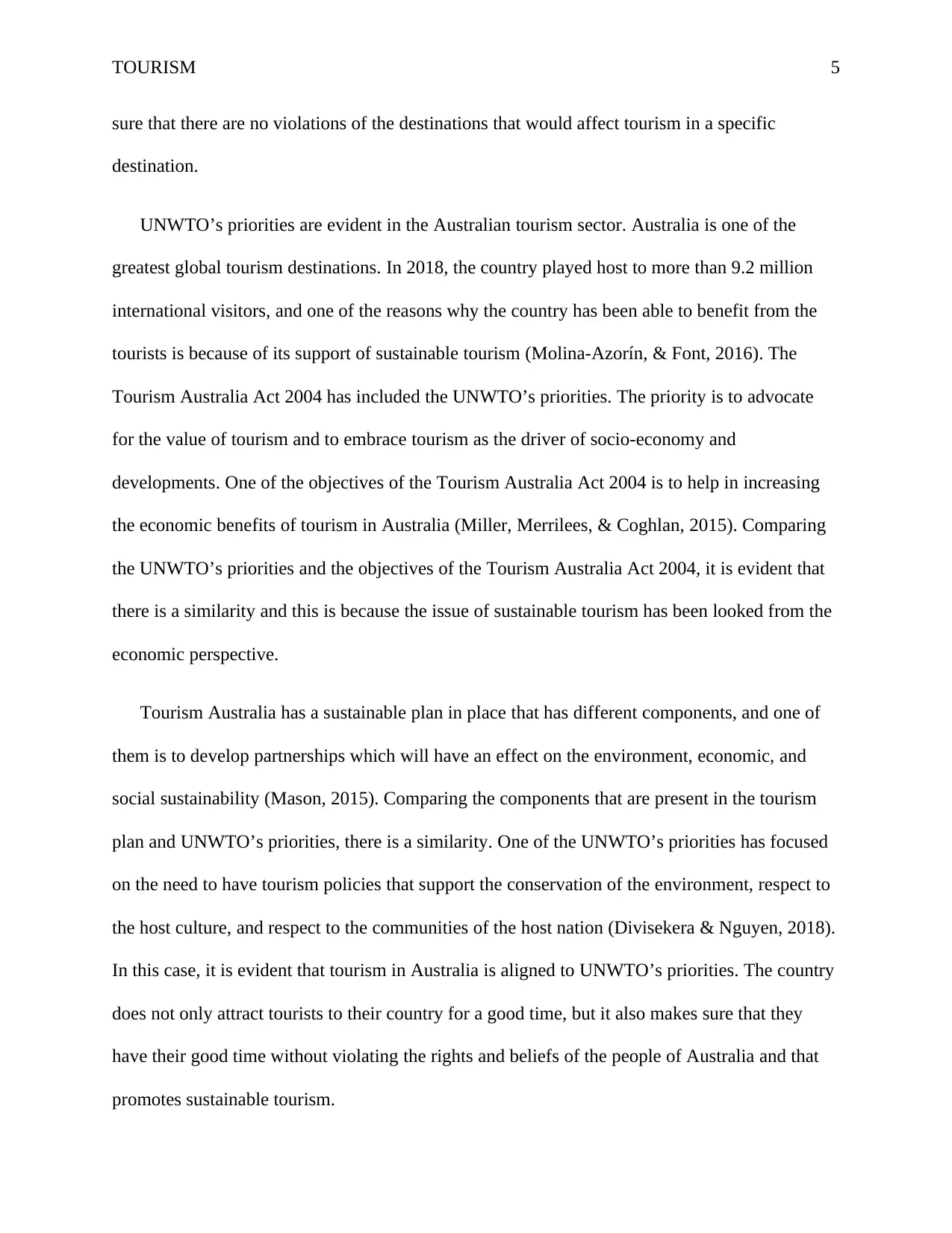
TOURISM 5
sure that there are no violations of the destinations that would affect tourism in a specific
destination.
UNWTO’s priorities are evident in the Australian tourism sector. Australia is one of the
greatest global tourism destinations. In 2018, the country played host to more than 9.2 million
international visitors, and one of the reasons why the country has been able to benefit from the
tourists is because of its support of sustainable tourism (Molina-Azorín, & Font, 2016). The
Tourism Australia Act 2004 has included the UNWTO’s priorities. The priority is to advocate
for the value of tourism and to embrace tourism as the driver of socio-economy and
developments. One of the objectives of the Tourism Australia Act 2004 is to help in increasing
the economic benefits of tourism in Australia (Miller, Merrilees, & Coghlan, 2015). Comparing
the UNWTO’s priorities and the objectives of the Tourism Australia Act 2004, it is evident that
there is a similarity and this is because the issue of sustainable tourism has been looked from the
economic perspective.
Tourism Australia has a sustainable plan in place that has different components, and one of
them is to develop partnerships which will have an effect on the environment, economic, and
social sustainability (Mason, 2015). Comparing the components that are present in the tourism
plan and UNWTO’s priorities, there is a similarity. One of the UNWTO’s priorities has focused
on the need to have tourism policies that support the conservation of the environment, respect to
the host culture, and respect to the communities of the host nation (Divisekera & Nguyen, 2018).
In this case, it is evident that tourism in Australia is aligned to UNWTO’s priorities. The country
does not only attract tourists to their country for a good time, but it also makes sure that they
have their good time without violating the rights and beliefs of the people of Australia and that
promotes sustainable tourism.
sure that there are no violations of the destinations that would affect tourism in a specific
destination.
UNWTO’s priorities are evident in the Australian tourism sector. Australia is one of the
greatest global tourism destinations. In 2018, the country played host to more than 9.2 million
international visitors, and one of the reasons why the country has been able to benefit from the
tourists is because of its support of sustainable tourism (Molina-Azorín, & Font, 2016). The
Tourism Australia Act 2004 has included the UNWTO’s priorities. The priority is to advocate
for the value of tourism and to embrace tourism as the driver of socio-economy and
developments. One of the objectives of the Tourism Australia Act 2004 is to help in increasing
the economic benefits of tourism in Australia (Miller, Merrilees, & Coghlan, 2015). Comparing
the UNWTO’s priorities and the objectives of the Tourism Australia Act 2004, it is evident that
there is a similarity and this is because the issue of sustainable tourism has been looked from the
economic perspective.
Tourism Australia has a sustainable plan in place that has different components, and one of
them is to develop partnerships which will have an effect on the environment, economic, and
social sustainability (Mason, 2015). Comparing the components that are present in the tourism
plan and UNWTO’s priorities, there is a similarity. One of the UNWTO’s priorities has focused
on the need to have tourism policies that support the conservation of the environment, respect to
the host culture, and respect to the communities of the host nation (Divisekera & Nguyen, 2018).
In this case, it is evident that tourism in Australia is aligned to UNWTO’s priorities. The country
does not only attract tourists to their country for a good time, but it also makes sure that they
have their good time without violating the rights and beliefs of the people of Australia and that
promotes sustainable tourism.
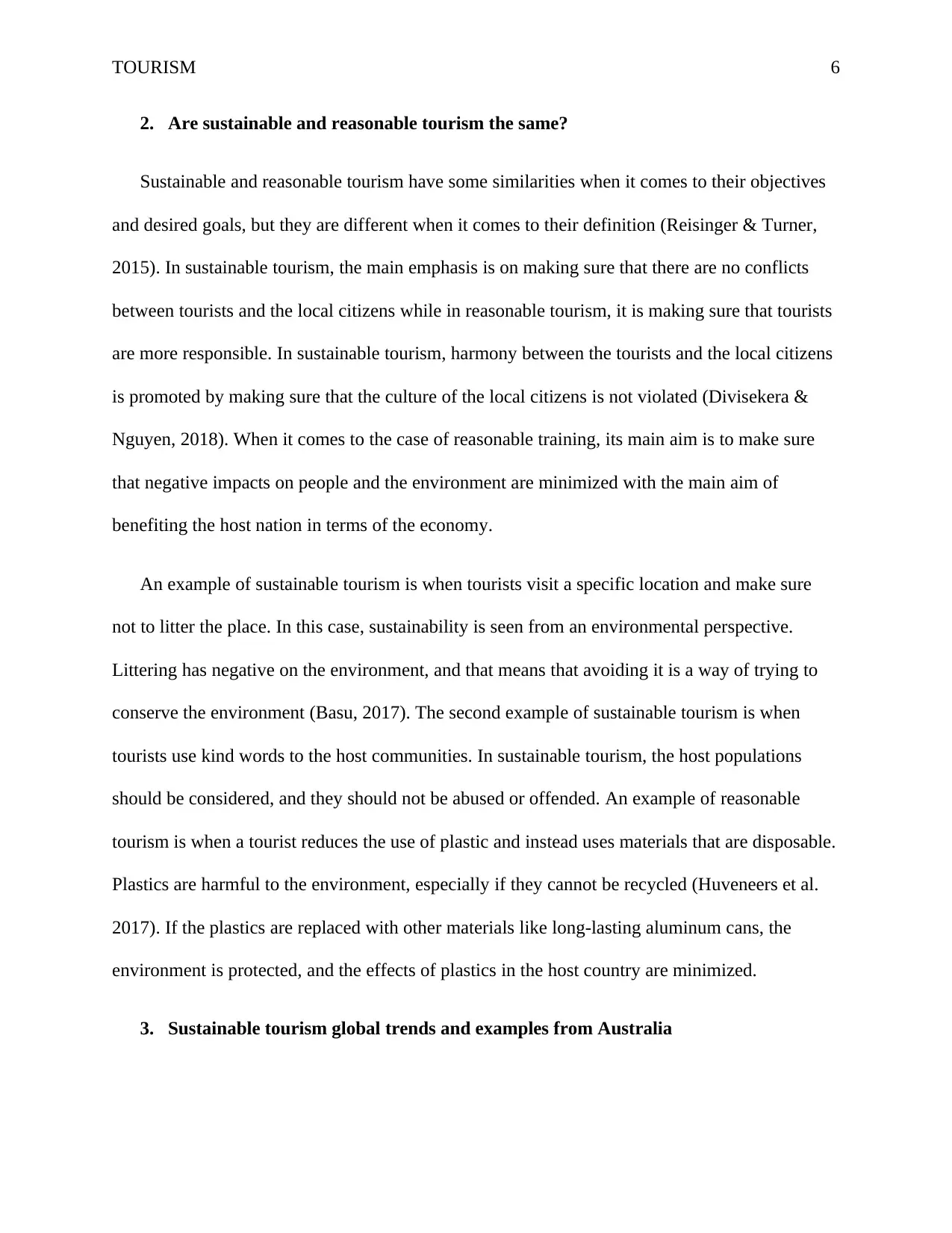
TOURISM 6
2. Are sustainable and reasonable tourism the same?
Sustainable and reasonable tourism have some similarities when it comes to their objectives
and desired goals, but they are different when it comes to their definition (Reisinger & Turner,
2015). In sustainable tourism, the main emphasis is on making sure that there are no conflicts
between tourists and the local citizens while in reasonable tourism, it is making sure that tourists
are more responsible. In sustainable tourism, harmony between the tourists and the local citizens
is promoted by making sure that the culture of the local citizens is not violated (Divisekera &
Nguyen, 2018). When it comes to the case of reasonable training, its main aim is to make sure
that negative impacts on people and the environment are minimized with the main aim of
benefiting the host nation in terms of the economy.
An example of sustainable tourism is when tourists visit a specific location and make sure
not to litter the place. In this case, sustainability is seen from an environmental perspective.
Littering has negative on the environment, and that means that avoiding it is a way of trying to
conserve the environment (Basu, 2017). The second example of sustainable tourism is when
tourists use kind words to the host communities. In sustainable tourism, the host populations
should be considered, and they should not be abused or offended. An example of reasonable
tourism is when a tourist reduces the use of plastic and instead uses materials that are disposable.
Plastics are harmful to the environment, especially if they cannot be recycled (Huveneers et al.
2017). If the plastics are replaced with other materials like long-lasting aluminum cans, the
environment is protected, and the effects of plastics in the host country are minimized.
3. Sustainable tourism global trends and examples from Australia
2. Are sustainable and reasonable tourism the same?
Sustainable and reasonable tourism have some similarities when it comes to their objectives
and desired goals, but they are different when it comes to their definition (Reisinger & Turner,
2015). In sustainable tourism, the main emphasis is on making sure that there are no conflicts
between tourists and the local citizens while in reasonable tourism, it is making sure that tourists
are more responsible. In sustainable tourism, harmony between the tourists and the local citizens
is promoted by making sure that the culture of the local citizens is not violated (Divisekera &
Nguyen, 2018). When it comes to the case of reasonable training, its main aim is to make sure
that negative impacts on people and the environment are minimized with the main aim of
benefiting the host nation in terms of the economy.
An example of sustainable tourism is when tourists visit a specific location and make sure
not to litter the place. In this case, sustainability is seen from an environmental perspective.
Littering has negative on the environment, and that means that avoiding it is a way of trying to
conserve the environment (Basu, 2017). The second example of sustainable tourism is when
tourists use kind words to the host communities. In sustainable tourism, the host populations
should be considered, and they should not be abused or offended. An example of reasonable
tourism is when a tourist reduces the use of plastic and instead uses materials that are disposable.
Plastics are harmful to the environment, especially if they cannot be recycled (Huveneers et al.
2017). If the plastics are replaced with other materials like long-lasting aluminum cans, the
environment is protected, and the effects of plastics in the host country are minimized.
3. Sustainable tourism global trends and examples from Australia
⊘ This is a preview!⊘
Do you want full access?
Subscribe today to unlock all pages.

Trusted by 1+ million students worldwide
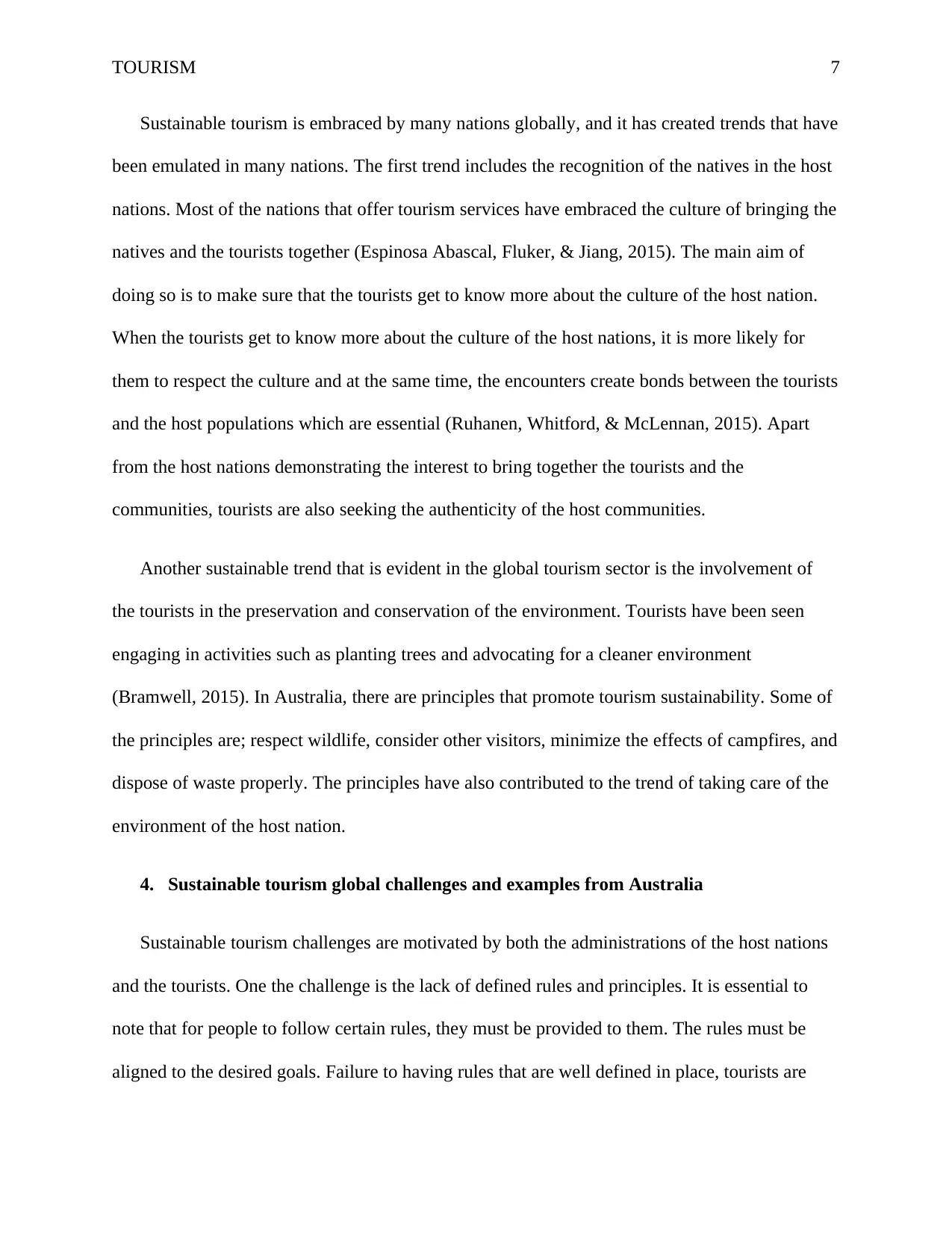
TOURISM 7
Sustainable tourism is embraced by many nations globally, and it has created trends that have
been emulated in many nations. The first trend includes the recognition of the natives in the host
nations. Most of the nations that offer tourism services have embraced the culture of bringing the
natives and the tourists together (Espinosa Abascal, Fluker, & Jiang, 2015). The main aim of
doing so is to make sure that the tourists get to know more about the culture of the host nation.
When the tourists get to know more about the culture of the host nations, it is more likely for
them to respect the culture and at the same time, the encounters create bonds between the tourists
and the host populations which are essential (Ruhanen, Whitford, & McLennan, 2015). Apart
from the host nations demonstrating the interest to bring together the tourists and the
communities, tourists are also seeking the authenticity of the host communities.
Another sustainable trend that is evident in the global tourism sector is the involvement of
the tourists in the preservation and conservation of the environment. Tourists have been seen
engaging in activities such as planting trees and advocating for a cleaner environment
(Bramwell, 2015). In Australia, there are principles that promote tourism sustainability. Some of
the principles are; respect wildlife, consider other visitors, minimize the effects of campfires, and
dispose of waste properly. The principles have also contributed to the trend of taking care of the
environment of the host nation.
4. Sustainable tourism global challenges and examples from Australia
Sustainable tourism challenges are motivated by both the administrations of the host nations
and the tourists. One the challenge is the lack of defined rules and principles. It is essential to
note that for people to follow certain rules, they must be provided to them. The rules must be
aligned to the desired goals. Failure to having rules that are well defined in place, tourists are
Sustainable tourism is embraced by many nations globally, and it has created trends that have
been emulated in many nations. The first trend includes the recognition of the natives in the host
nations. Most of the nations that offer tourism services have embraced the culture of bringing the
natives and the tourists together (Espinosa Abascal, Fluker, & Jiang, 2015). The main aim of
doing so is to make sure that the tourists get to know more about the culture of the host nation.
When the tourists get to know more about the culture of the host nations, it is more likely for
them to respect the culture and at the same time, the encounters create bonds between the tourists
and the host populations which are essential (Ruhanen, Whitford, & McLennan, 2015). Apart
from the host nations demonstrating the interest to bring together the tourists and the
communities, tourists are also seeking the authenticity of the host communities.
Another sustainable trend that is evident in the global tourism sector is the involvement of
the tourists in the preservation and conservation of the environment. Tourists have been seen
engaging in activities such as planting trees and advocating for a cleaner environment
(Bramwell, 2015). In Australia, there are principles that promote tourism sustainability. Some of
the principles are; respect wildlife, consider other visitors, minimize the effects of campfires, and
dispose of waste properly. The principles have also contributed to the trend of taking care of the
environment of the host nation.
4. Sustainable tourism global challenges and examples from Australia
Sustainable tourism challenges are motivated by both the administrations of the host nations
and the tourists. One the challenge is the lack of defined rules and principles. It is essential to
note that for people to follow certain rules, they must be provided to them. The rules must be
aligned to the desired goals. Failure to having rules that are well defined in place, tourists are
Paraphrase This Document
Need a fresh take? Get an instant paraphrase of this document with our AI Paraphraser
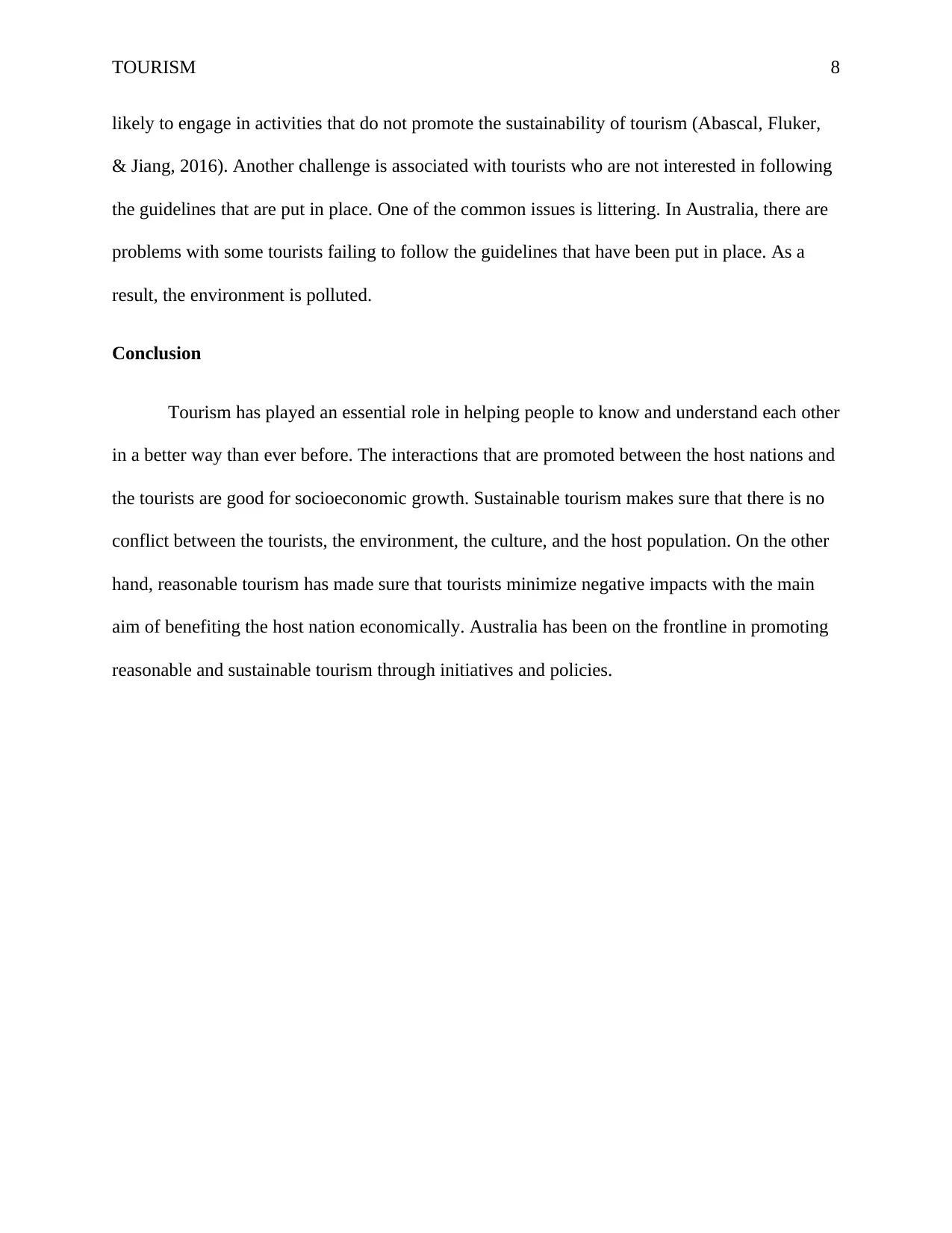
TOURISM 8
likely to engage in activities that do not promote the sustainability of tourism (Abascal, Fluker,
& Jiang, 2016). Another challenge is associated with tourists who are not interested in following
the guidelines that are put in place. One of the common issues is littering. In Australia, there are
problems with some tourists failing to follow the guidelines that have been put in place. As a
result, the environment is polluted.
Conclusion
Tourism has played an essential role in helping people to know and understand each other
in a better way than ever before. The interactions that are promoted between the host nations and
the tourists are good for socioeconomic growth. Sustainable tourism makes sure that there is no
conflict between the tourists, the environment, the culture, and the host population. On the other
hand, reasonable tourism has made sure that tourists minimize negative impacts with the main
aim of benefiting the host nation economically. Australia has been on the frontline in promoting
reasonable and sustainable tourism through initiatives and policies.
likely to engage in activities that do not promote the sustainability of tourism (Abascal, Fluker,
& Jiang, 2016). Another challenge is associated with tourists who are not interested in following
the guidelines that are put in place. One of the common issues is littering. In Australia, there are
problems with some tourists failing to follow the guidelines that have been put in place. As a
result, the environment is polluted.
Conclusion
Tourism has played an essential role in helping people to know and understand each other
in a better way than ever before. The interactions that are promoted between the host nations and
the tourists are good for socioeconomic growth. Sustainable tourism makes sure that there is no
conflict between the tourists, the environment, the culture, and the host population. On the other
hand, reasonable tourism has made sure that tourists minimize negative impacts with the main
aim of benefiting the host nation economically. Australia has been on the frontline in promoting
reasonable and sustainable tourism through initiatives and policies.
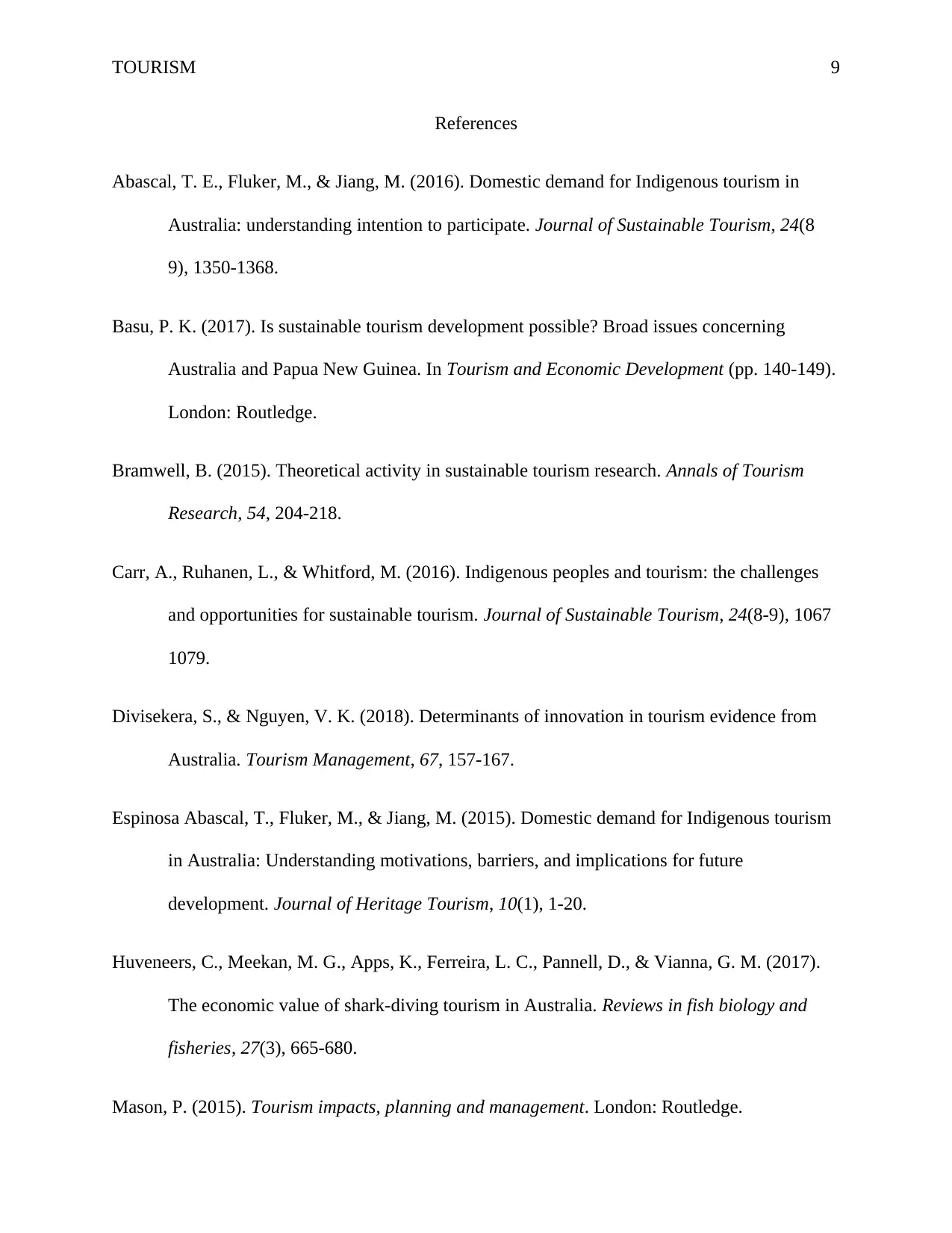
TOURISM 9
References
Abascal, T. E., Fluker, M., & Jiang, M. (2016). Domestic demand for Indigenous tourism in
Australia: understanding intention to participate. Journal of Sustainable Tourism, 24(8
9), 1350-1368.
Basu, P. K. (2017). Is sustainable tourism development possible? Broad issues concerning
Australia and Papua New Guinea. In Tourism and Economic Development (pp. 140-149).
London: Routledge.
Bramwell, B. (2015). Theoretical activity in sustainable tourism research. Annals of Tourism
Research, 54, 204-218.
Carr, A., Ruhanen, L., & Whitford, M. (2016). Indigenous peoples and tourism: the challenges
and opportunities for sustainable tourism. Journal of Sustainable Tourism, 24(8-9), 1067
1079.
Divisekera, S., & Nguyen, V. K. (2018). Determinants of innovation in tourism evidence from
Australia. Tourism Management, 67, 157-167.
Espinosa Abascal, T., Fluker, M., & Jiang, M. (2015). Domestic demand for Indigenous tourism
in Australia: Understanding motivations, barriers, and implications for future
development. Journal of Heritage Tourism, 10(1), 1-20.
Huveneers, C., Meekan, M. G., Apps, K., Ferreira, L. C., Pannell, D., & Vianna, G. M. (2017).
The economic value of shark-diving tourism in Australia. Reviews in fish biology and
fisheries, 27(3), 665-680.
Mason, P. (2015). Tourism impacts, planning and management. London: Routledge.
References
Abascal, T. E., Fluker, M., & Jiang, M. (2016). Domestic demand for Indigenous tourism in
Australia: understanding intention to participate. Journal of Sustainable Tourism, 24(8
9), 1350-1368.
Basu, P. K. (2017). Is sustainable tourism development possible? Broad issues concerning
Australia and Papua New Guinea. In Tourism and Economic Development (pp. 140-149).
London: Routledge.
Bramwell, B. (2015). Theoretical activity in sustainable tourism research. Annals of Tourism
Research, 54, 204-218.
Carr, A., Ruhanen, L., & Whitford, M. (2016). Indigenous peoples and tourism: the challenges
and opportunities for sustainable tourism. Journal of Sustainable Tourism, 24(8-9), 1067
1079.
Divisekera, S., & Nguyen, V. K. (2018). Determinants of innovation in tourism evidence from
Australia. Tourism Management, 67, 157-167.
Espinosa Abascal, T., Fluker, M., & Jiang, M. (2015). Domestic demand for Indigenous tourism
in Australia: Understanding motivations, barriers, and implications for future
development. Journal of Heritage Tourism, 10(1), 1-20.
Huveneers, C., Meekan, M. G., Apps, K., Ferreira, L. C., Pannell, D., & Vianna, G. M. (2017).
The economic value of shark-diving tourism in Australia. Reviews in fish biology and
fisheries, 27(3), 665-680.
Mason, P. (2015). Tourism impacts, planning and management. London: Routledge.
⊘ This is a preview!⊘
Do you want full access?
Subscribe today to unlock all pages.

Trusted by 1+ million students worldwide
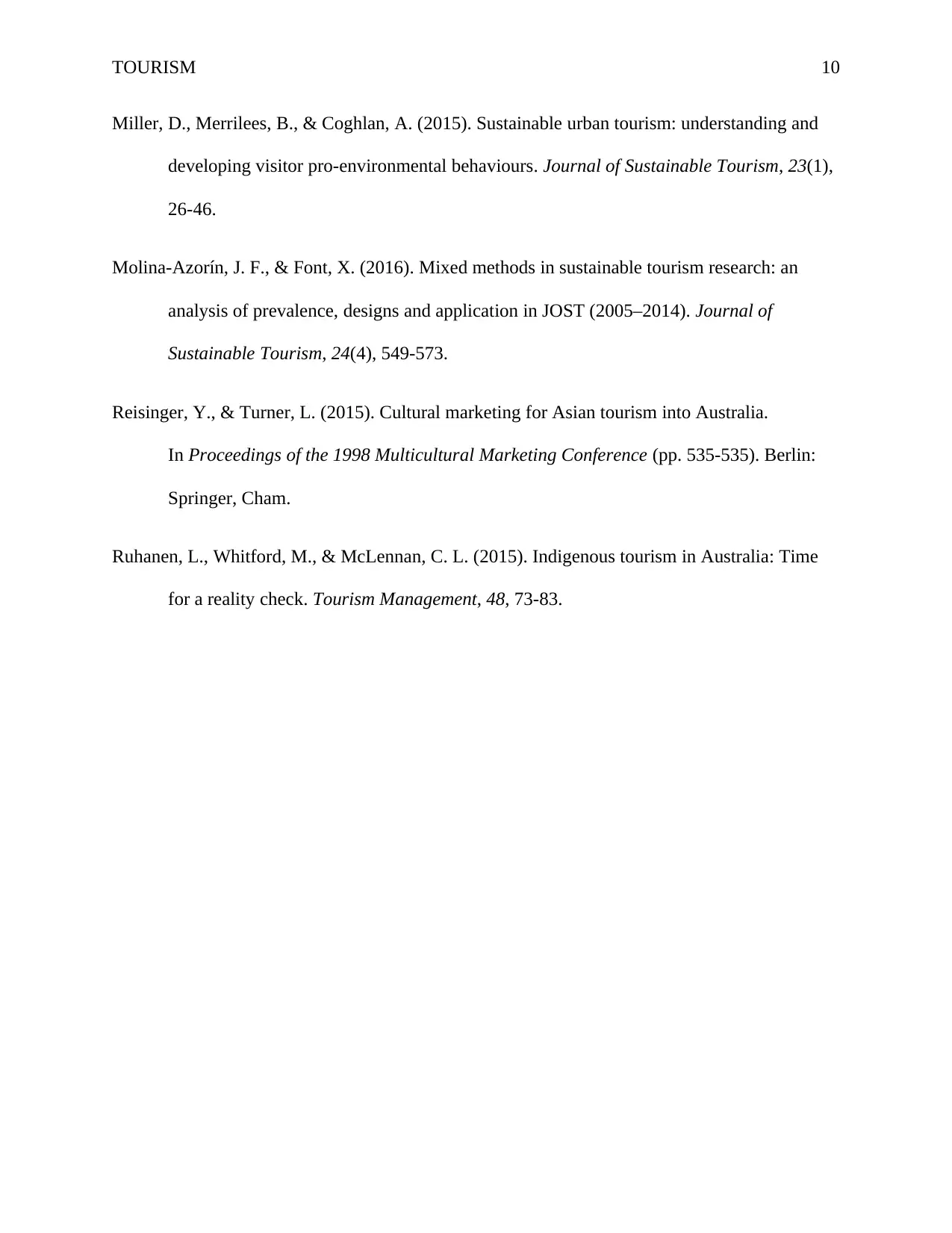
TOURISM 10
Miller, D., Merrilees, B., & Coghlan, A. (2015). Sustainable urban tourism: understanding and
developing visitor pro-environmental behaviours. Journal of Sustainable Tourism, 23(1),
26-46.
Molina-Azorín, J. F., & Font, X. (2016). Mixed methods in sustainable tourism research: an
analysis of prevalence, designs and application in JOST (2005–2014). Journal of
Sustainable Tourism, 24(4), 549-573.
Reisinger, Y., & Turner, L. (2015). Cultural marketing for Asian tourism into Australia.
In Proceedings of the 1998 Multicultural Marketing Conference (pp. 535-535). Berlin:
Springer, Cham.
Ruhanen, L., Whitford, M., & McLennan, C. L. (2015). Indigenous tourism in Australia: Time
for a reality check. Tourism Management, 48, 73-83.
Miller, D., Merrilees, B., & Coghlan, A. (2015). Sustainable urban tourism: understanding and
developing visitor pro-environmental behaviours. Journal of Sustainable Tourism, 23(1),
26-46.
Molina-Azorín, J. F., & Font, X. (2016). Mixed methods in sustainable tourism research: an
analysis of prevalence, designs and application in JOST (2005–2014). Journal of
Sustainable Tourism, 24(4), 549-573.
Reisinger, Y., & Turner, L. (2015). Cultural marketing for Asian tourism into Australia.
In Proceedings of the 1998 Multicultural Marketing Conference (pp. 535-535). Berlin:
Springer, Cham.
Ruhanen, L., Whitford, M., & McLennan, C. L. (2015). Indigenous tourism in Australia: Time
for a reality check. Tourism Management, 48, 73-83.
1 out of 10
Related Documents
Your All-in-One AI-Powered Toolkit for Academic Success.
+13062052269
info@desklib.com
Available 24*7 on WhatsApp / Email
![[object Object]](/_next/static/media/star-bottom.7253800d.svg)
Unlock your academic potential
Copyright © 2020–2025 A2Z Services. All Rights Reserved. Developed and managed by ZUCOL.




